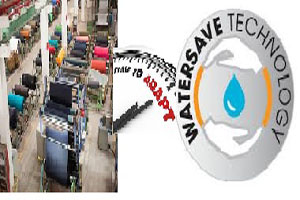
Time for textile industry to adapt modern technologies to save water
YarnsandFibers News Bureau 2015-03-24 10:00:00 – MumbaiThe textile industry, one of the most water dependent industries is also the backbone of many developing economies. With the incorporation of new technologies such as waterless dyeing technology, digital printing etc can help conserve water and help mills remain competitive while reducing their dependence on water and contributing to a better environment.
From farm to factory to favorite store, new cotton T-shirt required approximately 2,650 litres of water to grow, produce and transport. A substantial proportion of this water usage - 20 percent and more when using conventional methods - is used in just the dyeing phase of the process. Up to 100 litres of fresh water, and very high amount of energy, is required to dye just one kilogram of cotton fabric.
Much of this water ends up contaminated by the salt used to promote the absorption of the dye. This salinated waste water is difficult to treat, and it cannot be safely consumed or used for irrigation, and it is harmful to aquatic life.
These challenges are aggravated in regions facing acute water scarcity. Unfortunately, many of the world’s largest textile-producing nations – China, India, Bangladesh and Brazil, for example – are also those most vulnerable to water shortages.
The public in these textile-producing countries is becoming increasingly vocal about deteriorating water quality and the lack of sufficient clean water for homes and agriculture. People in the developed world are also beginning to demand that the garments and textile products they buy are eco-friendly.
This attitude change is putting pressure on brands and retailers to show that their supply chains are clean and transparent. Governments too have reacted by mandating more stringent environmental legislation and by more strictly enforcing their pollution laws.
Even so, the United Nations is warning that half the global population could be facing water shortages by 2030.
Taken together, all of these factors make reducing our use of water one of the most pressing challenges facing the textile industry.
A great deal can be done today to reduce the industry’s reliance on water. Process and efficiency improvements can have some impact, but dramatic gains are needed.
Waterless dyeing technology has been under development for several years. Recently, innovative sustainable products were developed by using recyclable carbon dioxide (supercritical CO2) as the application medium to infuse colour into fabric instead of water. This completely eliminated the use of water in the textile dyeing process and would benefit the industry in years to come.
Digital textile printing has also come of age. It requires mills to invest heavily in digital printing machines and to retrain staff and use high-quality specialist inks, but it is now cost-effective for higher value fabrics. Digital printing allows mills to print an almost unlimited array of colours and complex patterns in short runs. It is also a very clean process that minimizes waste and substantially reduces water and energy consumption.
Perhaps even more promising, however, are developments that help mills make dramatic savings without requiring substantial investment in new plant or equipment. These new innovation are a range of reactive dyes for cotton and cellulosic fibres using technology that assists in them getting absorbed by textile fibres more rapidly, using less salt during dyeing and less water during the wash-off process. These unique set of properties ensure high-quality results at much lower costs along with improved environment acceptability.
Even more dramatic gains are delivered against conventional dye house technologies, which many mills in developing nations still use. Statistically, this new and exciting technology could potentially save more than 820 billion litres of water per year, which equates to 1.3 litres of fresh water per person per day in the major Asian textile processing countries
It has become necessary that textile industry must lead the way with new dye technologies and cleaner processes that save water and energy.
Another way to reduce reliance on cotton, the industry can invest in less-thirsty alternative fibres, such as bamboo and other man-made fibres and recycled polyester. They will improve laundry equipment and detergents for industrial and home use.
Mills that serve high-volume, low-cost retailers have very small margins which is resulting in some closing because they cannot meet tougher environmental regulations.
Changing the mindset of producers about water conservation will need to be an industry priority to accelerate the pace of change. Simple changes like fixing leaks, installing sensors and water meters, collecting the monsoon rains, and switching to new dyes can all pay big.
The textile industry has reached at an inflection point today, with environmental and competitive pressures demanding new approaches.
Market Intelligence
Ask for free sample Report

experience
Customer Base
dedicated team
Countries Served Worldwide









